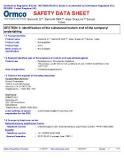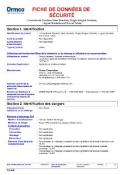Ormco Orthodontic Solutions:
Understanding Material Safety Data Sheets (MSDS)
What Information is Included in Ormco MSDS Sheets?
Ormco MSDS sheets encompass a wide range of essential information, including:
Product Identification:
Unique product name
Chemical Abstract Service (CAS) number for easy identification
Manufacturer information (Ormco Corporation)
Emergency contact information for immediate assistance in case of an incident.
Hazard Identification:
- Globally Harmonized System (GHS) classification, detailing potential health, physical, and environmental hazards.
- Clear labeling instructions, including pictograms, signal words, and hazard statements.
Composition/Information on Ingredients:
- A complete list of ingredients with their respective concentrations and CAS numbers.
First Aid Measures:
- Step-by-step guidance on how to handle potential exposures, such as inhalation, skin contact, eye contact, and ingestion.
Firefighting Measures:
- Suitable extinguishing agents, special fire-fighting hazards, and recommended equipment for firefighters.
Accidental Release Measures:
- Personal precautions, environmental protection measures, and safe cleanup procedures for spills or leaks.
Handling and Storage:
- Safe handling practices and recommended storage conditions to minimize risks.
Exposure Controls/Personal Protection:
- Permissible exposure limits (PELs) or occupational exposure limits (OELs).
- Recommended Personal Protective Equipment (PPE), such as gloves, eye protection, and respiratory protection.
Physical and Chemical Properties:
- Key physical properties like appearance, odor, pH, melting/freezing point, and boiling point.
- Information on flammability, reactivity, and stability.
Toxicological Information:
- Potential acute and chronic health effects, including toxicity, irritation, sensitization, mutagenicity, carcinogenicity, and reproductive toxicity.
Ecological Information:
- Potential impacts on the environment, including ecotoxicity, persistence, bioaccumulation, and mobility.
Disposal Considerations:
- Recommended methods for safe disposal of the product and its packaging.
Transport Information:
- Transportation classification, including UN number, proper shipping name, hazard class, and packing group.
Regulatory Information:
- Compliance with relevant regulations and standards.
Why are Ormco MSDS Sheets Important?
Ormco MSDS sheets play a crucial role in:
Ensuring employee safety:
- By providing essential information about potential hazards and safe handling practices.
- Protecting the environment: By outlining measures to prevent environmental contamination.
- Meeting regulatory requirements: By ensuring compliance with relevant safety and environmental regulations.
- Promoting responsible product use: By empowering users with the knowledge to handle and use orthodontic products safely and effectively.
By providing this comprehensive information, Ormco demonstrates its commitment to safety and transparency, fostering a safer and healthier workplace for everyone involved in the orthodontic industry.
Filter
Document type
Product
- AdvanSync (3)
- Alias (16)
- Blugloo (38)
- Copper Niti (3)
- Damon (1)
- Damon 3 (3)
- Damon 3 MX (16)
- Damon Clear (19)
- Damon Clear 2 (19)
- Damon Q (15)
- Damon Q2 (7)
- Damon Ultima (1)
- Enlight (35)
- Enlight LV (26)
- Etching Gel (35)
- Gel Etchant (3)
- GrenGloo (40)
- Inspire ICE (4)
- OrthoSolo (43)
- Peerless Cast Buccal Tubes (3)
- Porcelain Primer (32)
- Snaplink (19)
- Spark (4)
- Spirit MB (1)
- Straightwire (5)
- Symetri (5)
- Symetri Clear (11)
- Titanium Orthos (6)
- VectorTAS (6)
- Washbon (8)
Language
- Bulgarian (6)
- Chinese (China) (4)
- Croatian (12)
- Czech (11)
- Danish (20)
- Dutch (31)
- English (Canada) (2)
- English (UK) (44)
- English (US) (144)
- Estonian (11)
- Finnish (21)
- French (54)
- French (Canada) (61)
- German (66)
- Greek (19)
- Hungarian (13)
- Icelandic (10)
- Italian (53)
- Norwegian (18)
- Polish (15)
- Portuguese (Portugal) (15)
- Romanian (8)
- Russian (10)
- Slovak (2)
- Slovenian (1)
- Spanish (22)
- Swedish (23)





Safety Data Sheets (SDS)
SDS -Damon® Q™; Damon® 3MX™; Alias; SnapLink™ Buccal Tubes
Language
English (UK)

Safety Data Sheets (SDS)
SDS - Conventional Stainless Steel Brackets, Single Winged Brackets, Lingual Brackets and Buccal Tubes
Language
English (US)

Safety Data Sheets (SDS)
SDS - Conventional Stainless Steel Brackets, Single Winged Brackets, Lingual Brackets and Buccal Tubes
Language
French (Canada)

Safety Data Sheets (SDS)
SDS - Conventional Stainless Steel Brackets, Single Winged Brackets, Lingual Brackets and Buccal Tubes
Language
English (US)

Safety Data Sheets (SDS)
SDS - Titanium Buccal Tubes; Titanium Orthos
Language
English (US)

Safety Data Sheets (SDS)
SDS - Titanium Buccal Tubes; Titanium Orthos
Language
French (Canada)